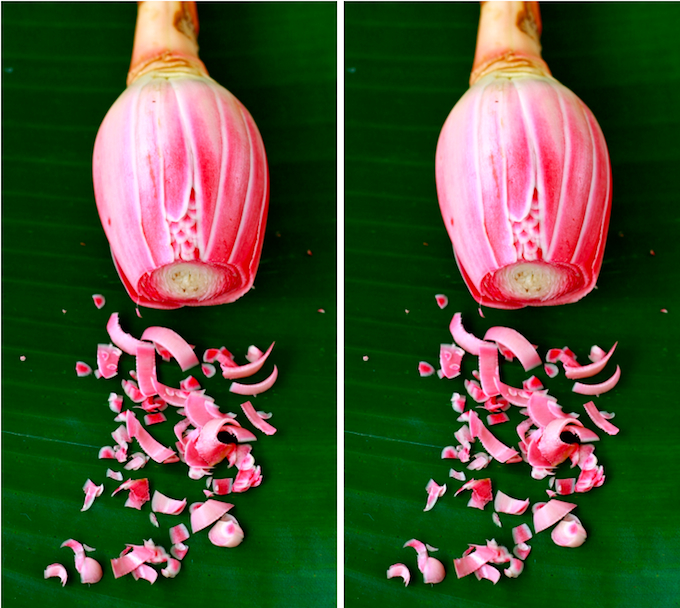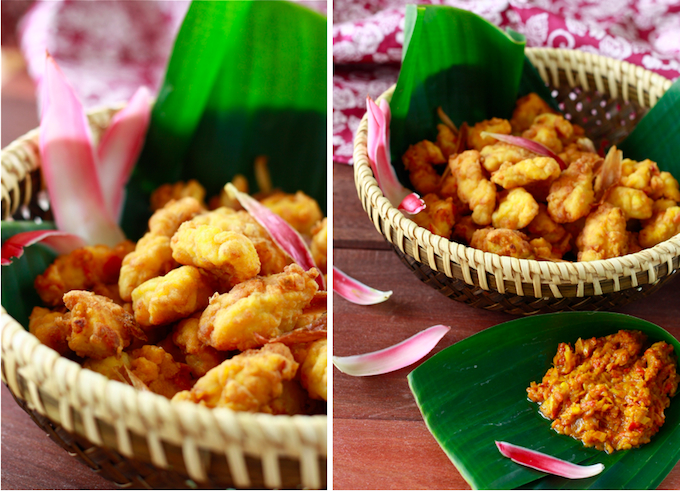Kicking a coconut shell back and forth; chickens ignoring us as they pecked at the gravel; the shifting shade of palm trees swaying in the wind. The long days never ended until a neighbor’s turkey would chase us back into the house, into the living room where our fathers sat, pointing fingers to the shower room, where we would pull the rope up with a bucket full of frigid water to dump over our heads. Ah! Sweet memories of my childhood.
Each year during school holidays, my sisters and I would ‘balik kampung’ (return home/to the village) with my mom, to spend a week with her side of the family in a village near Butterworth on the mainland of Penang. For an inner-city girl of George Town, the village stay was always an adventure.


While our mothers busied themselves in the kitchen all day, we would find our way back outside to play ‘masak-masak’ (cooking game) near a pond area. We would pound our ‘spices’ of wild flowers, leafy weeds, and even feathers we plucked from the duster. We would then pour the spices into the wok, and ‘cook’ it over a bed of sticks. Finally, serving the ‘food’ on banana leaves or coconut shells picked up from the field.
Sadly, like many villages in Penang, my grandma’s house was demolished ten years ago for a development project, forcing my grandma and aunt to move to the city. Although the kampung days of my childhood are only memories now, a simple dish, an ingredient, a kitchen tool, even a movement or sound, can immediately transport me back to my grandma’s house.
A sniff of the intoxicating scent of fresh torch ginger flower (bunga kantan). Steaming rice releasing the wonderful fragrance of banana leaves. The sizzling, crackling, spitting wok.
Infused with the floral essence of torch ginger, this crispy fried chicken has the rustic charm reminiscent of my kampung days.
Served piping hot, the chicken is golden crunchy on the outside with a subtle yet delightful floral gingery flavor as you take your first bite of the tender white meat.
This tropical marinade is also a dipping sauce for the chicken. A mild alternative to the spicy sambals of Malaysia.
But don’t limit this torch ginger marinade/sauce to chicken. The subtle flavors are an exciting complement to fried calamari or prawns.
Are you hungry now? Let’s play masak-masak in a real kitchen!
Bunga Kantan Marinade & Sauce for Crispy Fried Chicken
by Season with SpiceIngredients:
Fried Chicken -
2 chicken breasts, skinned and cubed into bite size pieces
1 cup of cooking oil
1/2 cup all-purpose flour
Marinate & Sauce -
1 torch ginger flower, slice into small pieces
2.5 inch piece of fresh turmeric, cut into pieces
1 tbsp coriander powder
3 cloves garlic, smashed
2 fresh red chili, seeded & sliced thinly
5 shallots
1 tsp soy sauce
1 1/2 tbsp cooking oil
1/4 cup water
salt to taste
The process:
1. With a mortar and pestle (or food processor), pound the turmeric, coriander, garlic, chili, and shallots into a fine paste. Add a tiny bit of water if it gets too dry when pounding. The final texture should be moist. Then stir in torch ginger flower pieces and season with salt.
2. Marinate the chicken pieces with half of the paste. Let it sit for 15 minutes.
3. In a wok, heat up 1 1/2 tbsp oil. Add in the remaining half of the paste and saute for two minutes. Add 1/4 cup water and one teaspoon soy sauce, and simmer the sauce for another three minutes or until thickened. Remove sauce and set aside.
4. In a bowl, mix the flour with the marinated chicken. Make sure each piece is well coated with flour.
5. In the same wok, add one cup of oil and heat on high. When oil is heated, turn the flame down to medium. Place chicken pieces immediately into oil and fry for a few minutes, or until golden brown (will probably need to fry 2-3 batches).
6. Dish out and place on paper towel. Once dry, serve immediately with sauce.
Quick tip on deep frying:
Keep a few torch ginger flower petals (whole) to add in the frying oil. It will not only mask the taste of oil, but also create another layer of flavor. For any deep frying, I recommend adding spices to the oil, like curry leaves, pandan leaves, and so on.







